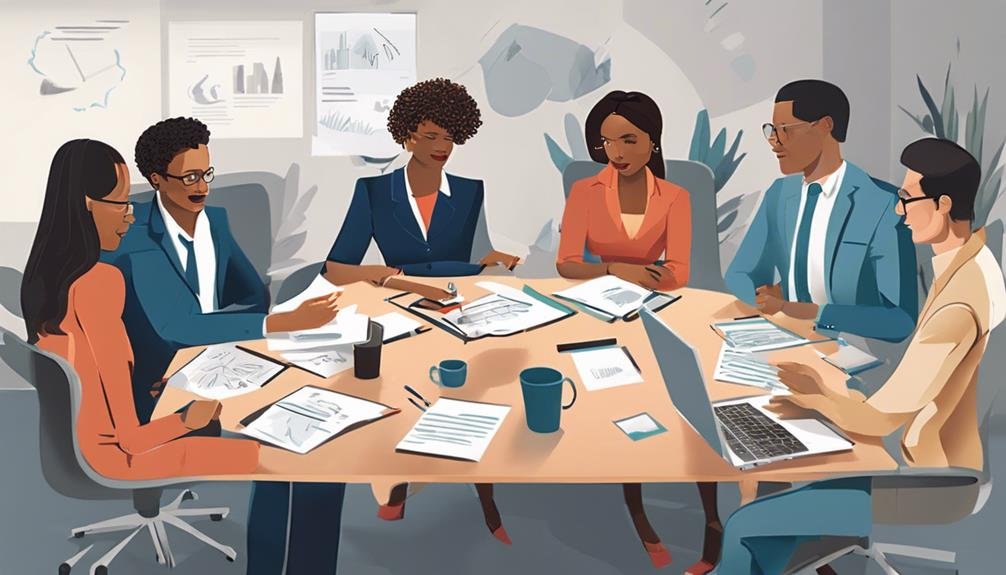Personality and Team Dynamics
When considering team dynamics, did you know that research shows that up to 65% of performance issues within teams are due to strained relationships among team members? Understanding how personalities interact within a team setting is key to fostering a cohesive and productive environment. By exploring the nuances of personality types, communication styles, and conflict resolution strategies, you can harness the potential for enhanced collaboration, innovation, and overall team success. So, how can you navigate these intricacies to build a high-performing team?
Key Takeaways
- Personality traits shape team dynamics, influencing communication and collaboration.
- Complementary traits enhance group synergy and problem-solving abilities.
- Conflicting traits can lead to communication breakdowns and misunderstandings.
- Recognizing individual dynamics is crucial for effective team functioning.
- Fostering a culture of personality diversity boosts team creativity and success.
Personality Traits Impacting Team Dynamics
Personality traits play an essential role in shaping team dynamics, influencing how individuals interact, communicate, and collaborate within a group setting. When examining personality compatibility within a team, it becomes apparent that certain traits can either enhance or hinder group dynamics. Individuals with complementary personalities tend to work more cohesively, leading to improved group dynamics and ultimately higher team productivity. On the other hand, conflicting personality traits can lead to friction, communication breakdowns, and decreased collaboration within the team.
Understanding individual dynamics is important in building an effective team. Each team member brings a unique set of personality traits, strengths, and weaknesses to the table. By recognizing and leveraging these individual dynamics, team leaders can create a more balanced and productive team environment. Additionally, fostering a culture that values diversity in personalities can lead to increased creativity, innovation, and overall team success.
Understanding Introverts and Extroverts
Within team dynamics, the understanding of introverts and extroverts is essential for optimizing collaboration and productivity. Introvert characteristics often include a preference for solitude, deep thinking, and strategic planning. Introverts tend to recharge their energy through alone time and may excel in tasks that require focused attention and analysis.
On the other hand, extrovert tendencies lean towards seeking social interactions, being outgoing, and enjoying teamwork. Extroverts typically thrive in dynamic environments, where quick decision-making and verbal communication play vital roles in achieving team goals.
When introvert characteristics and extrovert tendencies are recognized and valued within team dynamics, a balanced approach can be adopted to leverage the strengths of both personality traits. Introverts may contribute valuable insights and well-thought-out solutions, while extroverts can energize the team, facilitate discussions, and drive momentum towards achieving objectives.
Communication Styles in Team Settings
Understanding different communication styles in team settings is essential for optimizing collaboration and achieving team goals effectively. Communication styles play a pivotal role in team dynamics and can greatly impact interpersonal dynamics and group communication. In team settings, individuals may exhibit varying communication styles, such as assertive, passive, aggressive, or passive-aggressive. Recognizing and adapting to these styles can enhance overall team effectiveness.
Effective communication styles promote open dialogue, active listening, and constructive feedback within teams. By understanding and respecting each team member's preferred communication style, teams can foster a more inclusive and collaborative environment. For instance, some team members may prefer direct and concise communication, while others may value a more empathetic and relationship-focused approach. Adapting communication strategies to accommodate these preferences can lead to improved team cohesion and productivity.
Moreover, being mindful of non-verbal cues, such as body language and tone of voice, is crucial for effective communication in team settings. These subtle signals can convey emotions and attitudes, influencing how messages are received and interpreted by team members. By being attuned to both verbal and non-verbal aspects of communication, teams can navigate conflicts, build trust, and strengthen relationships, ultimately contributing to overall team success.
Leveraging Diversity for Team Success
To achieve team success, it's essential to embrace different perspectives within the group. Research shows that diverse teams have a higher potential for enhancing collaboration and generating innovative solutions.
Embracing Different Perspectives
Diverse perspectives within a team are essential for discovering innovative solutions and achieving peak performance. Valuing different perspectives and fostering creativity can lead to a more dynamic and successful team.
When a team embraces diversity, it enhances teamwork by bringing together individuals with unique backgrounds, experiences, and ways of thinking. Research shows that diverse teams are more likely to outperform homogenous teams due to their ability to approach challenges from multiple angles and generate a wider range of ideas.
Enhancing Collaboration Through Diversity
Embracing a variety of perspectives within a team not only fosters creativity but also serves as a catalyst for enhancing collaboration and ultimately leveraging diversity for team success.
Cultural sensitivity plays an essential role in this process, as it involves an awareness and understanding of different cultural norms, values, and communication styles. By being culturally sensitive, team members can navigate potential misunderstandings and conflicts more effectively, paving the way for smoother collaboration.
Inclusive leadership is another key factor in enhancing collaboration through diversity. Leaders who embrace inclusivity actively seek out and value diverse perspectives, creating an environment where all team members feel heard and respected. This leadership style not only promotes a sense of belonging among team members but also encourages innovation and creativity by drawing on a wide range of experiences and ideas.
Leveraging Unique Strengths
Utilizing individuals' distinct talents and capabilities within a team setting is essential for maximizing diversity's impact on team success. Strength identification is a pivotal aspect of leveraging unique strengths. By recognizing and harnessing the individual contributions that team members bring, teams can achieve higher levels of performance and innovation.
Research indicates that teams that actively identify and leverage their members' unique strengths outperform those that do not. When each team member's abilities are acknowledged and integrated into the team's overall strategy, a synergistic effect occurs, leading to enhanced problem-solving and creativity.
Moreover, the process of strength identification fosters a culture of appreciation and collaboration within the team. By valuing each member's contributions, individuals feel more engaged and motivated, leading to increased productivity and job satisfaction.
Conflict Resolution Strategies in Teams
When conflicts arise within your team, it's essential to employ effective conflict resolution strategies to maintain productivity and harmony.
Mediating team disputes allows for a neutral party to facilitate communication and find common ground.
Collaborative problem-solving and utilizing effective communication techniques are key components in resolving conflicts efficiently and fostering a positive team dynamic.
Mediating Team Disputes
Using effective conflict resolution strategies is essential for mediating team disputes and fostering a harmonious team dynamic. Conflict mediation plays an important role in resolving disputes and fostering unity within a team. When conflicts arise, it's important to address them promptly to avoid escalation and maintain team harmony.
One effective strategy is promoting open communication among team members to encourage dialogue and understanding. By creating a safe space for individuals to express their concerns and perspectives, teams can work towards finding mutually beneficial solutions.
Another valuable approach is practicing active listening during discussions to make certain all voices are heard and respected. This helps in building empathy and trust among team members, leading to smoother conflict resolution processes. Additionally, implementing clear guidelines and procedures for addressing conflicts can streamline the mediation process and prevent misunderstandings.
Collaborative Problem-Solving
Effective collaborative problem-solving is essential for enhancing team performance and fostering a cohesive work environment. Group problem solving involves utilizing brainstorming techniques to generate a variety of ideas and solutions. When teams collaborate effectively, they can leverage diverse perspectives and expertise to address complex issues.
Decision-making strategies play a significant role in collaborative problem-solving, as teams must weigh different options and come to a consensus on the best course of action. Research suggests that successful group problem solving is often characterized by open communication, active listening, and a willingness to explore alternative viewpoints.
Teams that engage in collaborative problem-solving tend to be more innovative and adaptable, leading to improved outcomes and increased team satisfaction. By fostering a culture of teamwork and cooperation, organizations can create an environment where employees feel empowered to contribute their ideas and work together towards common goals.
Effective Communication Techniques
Utilizing proven conflict resolution strategies in teams is essential for fostering effective communication and maintaining positive team dynamics. Active listening is a fundamental technique that involves fully concentrating, understanding, responding, and remembering what's being said. By actively listening, team members demonstrate respect, validate each other's perspectives, and minimize misunderstandings that can lead to conflicts.
Nonverbal cues, such as body language and facial expressions, play a significant role in communication within teams. Being aware of these cues can help team members interpret emotions, intentions, and attitudes accurately during discussions or disagreements, leading to more effective conflict resolution.
Conflict resolution strategies like compromise, collaboration, and negotiation are vital for addressing differences of opinion constructively. Encouraging open dialogue and creating a safe space where team members feel heard and valued can enhance communication effectiveness. By utilizing active listening and paying attention to nonverbal cues, teams can navigate conflicts more efficiently, strengthen relationships, and foster a harmonious team environment conducive to productivity and success.
Building Trust Among Team Members
Establishing a foundation of trust among team members is essential for fostering collaboration and achieving collective goals. Team building activities and trust exercises play an important role in developing a cohesive and trusting team environment. By engaging in activities that require communication, problem-solving, and reliance on one another, team members can build rapport and deepen their connections. Trust exercises such as blindfolded guiding or sharing personal experiences can help individuals in a team understand each other's strengths, weaknesses, and vulnerabilities, thereby creating a more empathetic and supportive team dynamic.
Fostering connections within the team isn't only about completing tasks together but also about creating a supportive and understanding environment where team members feel comfortable sharing ideas and concerns. Building rapport through informal conversations, team lunches, or social outings can also contribute significantly to trust-building.
Research shows that teams with high levels of trust among members tend to be more innovative, productive, and resilient in the face of challenges. Therefore, investing time and effort into building trust among team members can lead to more successful collaborations and outcomes.
Recognizing Strengths and Weaknesses
Recognizing the strengths and weaknesses of team members is essential for optimizing team performance and achieving collective goals. Identifying the unique strengths each team member brings to the table allows for better task allocation, where individuals can excel in areas aligned with their capabilities.
By acknowledging these strengths, teams can leverage them effectively to enhance overall productivity and quality of work.
Conversely, addressing weaknesses is equally important. It involves understanding where team members may require additional support or training to improve their skills. This recognition enables proactive measures to be taken, such as providing mentorship or training programs, to help individuals overcome their limitations and contribute more effectively to the team.
Research shows that teams that actively identify and work on both strengths and weaknesses tend to perform better and exhibit higher levels of satisfaction among team members. It fosters a culture of continuous improvement and development, ultimately leading to greater success in achieving team objectives.
Promoting Collaboration and Innovation
Encouraging a synergistic environment that nurtures teamwork and fosters creativity is paramount in cultivating collaboration and innovation within a team setting. Fostering creativity involves providing team members with the freedom to explore new ideas, experiment with different approaches, and think outside the box. This approach not only encourages innovation but also boosts morale by making team members feel valued and appreciated for their unique contributions.
Encouraging innovation within a team involves creating a culture that embraces change, welcomes new perspectives, and rewards risk-taking. By building relationships based on trust and open communication, team members feel comfortable sharing their ideas and working together towards common goals. This collaborative environment not only enhances team performance but also drives continuous improvement and growth.
Enhancing Team Performance Through Personality Analysis
To optimize team performance, conducting a thorough personality analysis of team members can provide valuable insights into how individual traits and characteristics contribute to overall team dynamics and success. Team assessment tools, such as personality assessments like the Myers-Briggs Type Indicator or the Big Five Personality Traits, can help teams understand each member's strengths, weaknesses, communication styles, and preferences. By analyzing these aspects, team leaders can strategically assign roles and responsibilities, foster better communication, and build a more cohesive team environment.
Furthermore, personality workshops can be instrumental in enhancing team performance by increasing self-awareness among team members, promoting empathy and understanding, and facilitating conflict resolution. These workshops can also help team members appreciate the diverse perspectives and approaches that each individual brings to the table.
Ultimately, by leveraging the insights gained from personality analysis and workshops, teams can harness the unique strengths of each member, optimize collaboration, and achieve higher levels of productivity and success.
Conclusion
To sum up, embracing the diversity of personalities within a team can lead to a symphony of collaboration and innovation. By understanding and valuing the unique traits each member brings to the table, teams can navigate conflicts, build trust, and ultimately enhance performance.
So, next time you find yourself in a team setting, remember that personality differences aren't obstacles but opportunities for growth and success. Embrace the quirks, celebrate the differences, and watch your team flourish.







